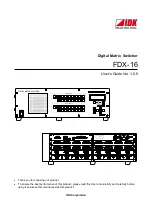
pg2
Button Switch Functions
Mode Switch:
The mode
has 4 options and is responsible for the most significant changes to the way the module
operates. The modes and their functions are defined below.
4LFO:
In this mode each of the 4 LFO function independently, each with their own frequency, wave, level and modulations.
Changes to the parameters of each LFO is done by selecting the LFO to edit with the LFO EDIT rotary switch knob.
The knobs become active and switch state LEDs update as each LFO is selected. This is the most typical mode when four
separate LFOs is needed.
Quad:
Quad is short for Quadrature. LFO1 is the master in this mode and only LFO1 is editable. The module functions like a
single LFO with 4 outputs in quadrature phase in this mode. LFO1s controls are global and editing panel controls are disabled
for the other 3 LFOs. Outputs 2,3 and 4 are respectively 90, 180 and 270 degrees out of phase with LFO1 but are in sync.
They use the same wave, frequency, level, CV routing etc as LFO1. This is a useful mode for quad panning or barberpole
effects. Also makes an interesting gate sequencer when used with Pulse output waves.
PHLOCK:
Is Phase Locked mode. LFO1 sets the RATE or frequency for all 4 LFOs but each LFO can be a division of the
master frequency. When editing LFO1 the RATE knob functions as it says. When editing LFOs 2-4 the RATE knob becomes
the control for setting the division of the LFO1 master frequency. Each LFO can have a different wave, level etc. This can be a
very unique mode especially when used with the last wave PATTERN. Each LFO can be outputting a different rhythm but all
are in sync and can be different divisions. Makes a great generator for drum patterns.
Rotate:
Rotate mode functions the same as 4LFO mode with the exception being that pulses to the GATE1 input
cause the LFOs to rotate to the right. For example after the first pulse LFO1 outputs on LFO2 out, LFO2 on output 3
LFO3 on output 4 and LFO4 on output 1. Each subsequent rotates this order 1 output to the right. This is a unique feature
similar to feeding the 4 LFOs to a sequential switch module. Some very complex modulations are possible in this mode.
SAVE:
To save all edits depress and hold the MODE/SAVE button for approximately 2 seconds (count 1000 and 1, 1000 and 2
at a moderate pace). The row of coloured buttons will flash sequentially when button is release to indicate save was
successful. If only the Mode LED changes colour the hold was too short.
Polarity Switch:
This switch is used to set the ouput range and inversion. There are 4 positions available.
5V:
The output swings between 0 and 5V and doesn’t go negative. The LEVEL control can be used to reduce this range
like a volume control. When level is at 0 the output is 0V
5V INV:
Is the same 0-5V range but waves are inverted. A rising STAIR wave becomes a falling STAIR for example.
10V:
The output swings b5V and -5V. The LEVEL control can be used to reduce this range but in this case it does so
symmetrical. For example at half level the output will be +/-2.5V.
10V INV:
The output swings b5V and -5V same as 10V setting. Once again the output is an inverted version of the
above.
Switch
User Interface:
The knobs on the Quad LFO can function in 2 different ways. The first is “Jump mode” and the second
is “Match mode”. In jump mode turning a knob makes it jump to the value of the current knob position. This mode provides
instant change of the knobs value but no feed-back regarding the value prior to making the edit. Match mode is the opposite.
The knob must be rotated till its value corresponds with the saved value before the edit takes effect. This requires some
searching to align the knobs position with the previous stored value but does provide feedback about the knob position stored
in memory from previous sessions. There are 3 possible choices. When powering up the module, depress and hold the MODE
button before switching on power. Hold it till the LEDs do their startup pattern. This will place the module in Jump mode.
Holding the Polarity button during power up will result in a combination of jump mode for all knobs except the WAVE knob
which will be in Match mode. The third option is match mode for all knobs. Holding in the range button will set to this mode.
Perform a SAVE after selection is made and now every time the unit is powered it will remember your choice. Follow the steps
above to change the mode at a later date. The default mode when shipped is “Jump mode”.
Range Switch:
The range switch sets the frequency or rate range for each LFO. The LOW range is .003Hz-51Hz and
the HIGH range 10Hz-1.6kHz. The low range is used for typical LFO duties while the high range extends into the audio range
ideal for FM modulation and also as a standalone audio source for drones etc. It is possible to control the pitch in this range
with CV but it is not setup for accurate 1V/Oct tracking although it is possible to get close by adjusting the CV Amount. The
morphing waves TAB1-3 can be an excellent source of audio textures in the high range.
synchronized clocking is possible. In this mode the function of the RATE knob changes to DIVision. The possible divisions of
the input clock are 1-16. The TAP button can be used instead to set the frequency in place of external clock. The division knob





















